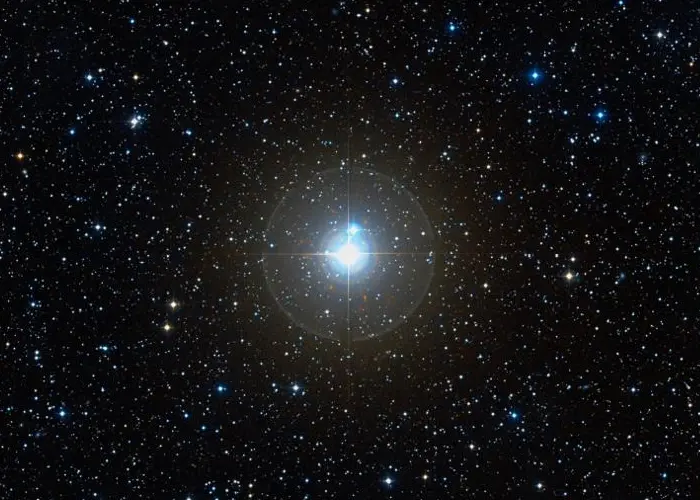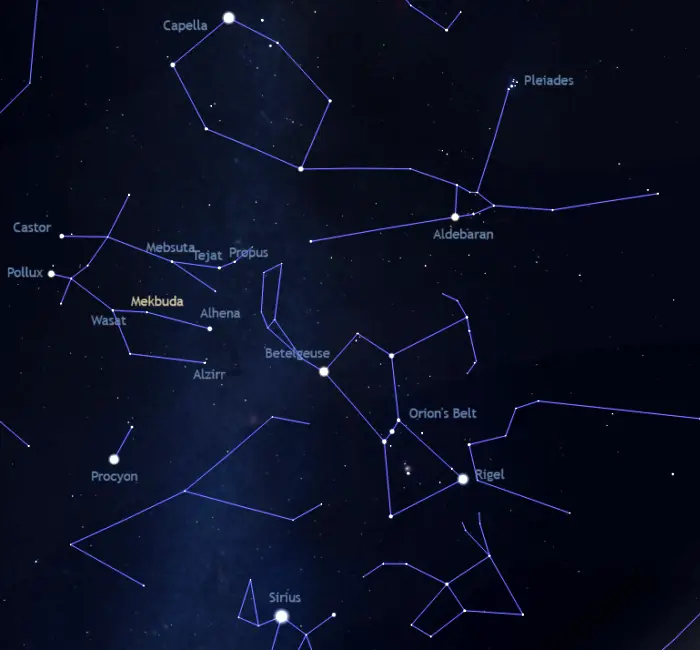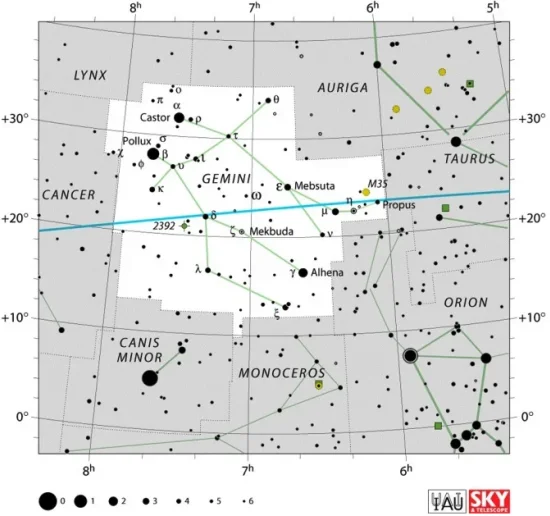Mekbuda, Zeta Geminorum (ζ Gem), is a supergiant star located approximately 1,120 light years away in the zodiac constellation Gemini. With an average apparent magnitude of 3.93, it is the 13th brightest star in the constellation. The supergiant is visible to the unaided eye from areas without too much light pollution.
Star system
Mekbuda is a supergiant star of the spectral type F7Ib-G3Ib. It has a mass 7.7 times that of the Sun and a radius about 65.24 times the Sun’s. With an effective temperature of 5,260–5,780 K, it is on average 2,900 times more luminous than the Sun. The supergiant spins at 19 km/s. It has an estimated age of around 70 million years.
Mekbuda is classified as a classical Cepheid variable. Its brightness varies from magnitude 3.68 to 4.16 over a period of 10.148 days. The period is decreasing by 3.1 seconds per year. As the star pulsates, its spectral type varies between F7Ib and G3Ib and its temperature fluctuates between 5,780 and 5,260 K. At the same time, the star’s radius varies between 61 and 69 solar radii.

Mekbuda (Zeta Geminorum), image: Wikisky
Classical Cepheids are young pulsating stars whose brightness varies by up to 2 magnitudes due to regular radial pulsations. The pulsation period corresponds to variations in the stars’ luminosity. The period-luminosity relationship makes these variable stars useful as standard candles for establishing distances to star clusters and galaxies. The Milky Way is believed to contain more than 6,000 classical Cepheids, of which 800 are currently known.
Other stars in this class include Polaris (the North Star) in the constellation Ursa Minor, l Carinae in Carina, Beta Doradus in Dorado, Eta Aquilae in Aquila, and the class prototype Delta Cephei in Cepheus.
Mekbuda is the primary component in a star system listed as WDS J07041+2034 in the Washington Double Star Catalog. Three companions are listed as components B, C, and D. They have been known since the 19th century.
The star WDS J07041+2034 B lies at a separation of 87.4 arcseconds. It is an 11th magnitude spectroscopic binary system with a combined spectrum of an F4 main sequence star. The star is believed to be physically associated with Mekbuda, as well as with a loose cluster of stars around the supergiant.
The brightest companion, WDS J07041+2034 C, shines at magnitude 7.6 and is catalogued as HD 268518. It is separated by about 101.3 arcseconds from Mekbuda. The star is a Sun-like yellow dwarf, now known to lie in the foreground.
The closest of the visual companions, WDS J07041+2034 D, shines at 12th magnitude and appears at a separation of 67.8 arcseconds from Mekbuda. It lies at a greater distance than the supergiant.
Other possible companions have been reported since, including a possible spectroscopic binary companion. However, the existence of the spectroscopic companion has not been confirmed.
Astronomers have found a diffuse cluster around Mekbuda. The cluster includes 26 stars located 355 parsecs away, the brightest of which are late B-type and early A-type giants. The star WDS J07041+2034 B is one of the faintest members.
Facts
Mekbuda was discovered to vary in brightness by the German astronomer Julius Schmidt in 1844. Schmidt found a variation period of about 10 days. The star was a suspected variable since 1790, when German astronomer Johann Friedrich Wurm mentioned its variability in the Berliner Jahrbuch. Even though it was known to be related to the Cepheid class, due to its symmetrical curve, the supergiant was often considered as the prototype for its own class of variable stars, the Geminids.
Variations in the star’s radial velocity were discovered by the American astronomer W. W. Campbell in 1899 and Russian astronomer Aristarkh Belopolsky in 1901. Campbell later derived orbital elements for the binary system but found irregularities and suggested that it may be a triple star system. The radial velocity variations were later found to be a result of the pulsations in the star’s atmosphere.
In 1920, German astronomer Paul Guthnick reported that the star’s periodicity itself was variable. He suspected that this was caused by an orbiting companion. Danish astronomer Axel Nielsen proposed that the period change was the result of a gradual decrease of 3.6 seconds per year.
Name
The name Mekbuda (pronunciation: /mɛkˈbjuːdə/) comes from an Arabic phrase meaning “the lion’s folded paw.” In ancient Arabic astronomy, Mekbuda and the brighter Mebsuta represented the paws of a lion. The lion (Asad) was much larger than the modern constellation Leo. Its forehead was marked by Regulus, its forepaws by Castor, Pollux and the stars of Canis Minor, its shin bones by Arcturus and Spica, and its hind quarters by the stars of Corvus.
The name Mekbuda was approved by the International Astronomical Union’s (IAU) Working Group on Star Names (WGSN) on September 12, 2016. It formally applies only to the primary component, Zeta Geminorum Aa, but is informally used for the whole star system.
In traditional Chinese astronomy, Mekbuda was known as 井宿七 (Jǐng Su qī), the Seventh Star of Well. It formed the Well asterism with Tejat (Mu Geminorum), Nu Geminorum, Alhena (Gamma Geminorum), Alzirr (Xi Geminorum), Mebsuta (Epsilon Geminorum), 36 Geminorum, and Lambda Geminorum. The asterism was part of the larger Well mansion, one of the southern mansions of the Vermilion Bird.
Location
Mekbuda is relatively easy to find because it lies in an area full of bright stars. It lies about a third of the way from Pollux, the brightest star in Gemini, to Betelgeuse at the shoulder of Orion, between Pollux and Alhena. Mekbuda is one of the several relatively bright stars in the region between Capella and Procyon.

Mekbuda location, image: Stellarium
Constellation
Mekbuda is located in the constellation of Gemini. It marks the left leg of Pollux, one of the celestial Twins.
Representing Pollux and Castor, Gemini is one of the 48 ancient constellations catalogued by the Greek astronomer Ptolemy in his Almagest in the 2nd century CE. It is the 30th constellation in size, stretching across 514 square degrees of the northern sky.
The constellation Gemini hosts Pollux (Beta Geminorum) and Castor (Alpha Geminorum), the 17th and 23rd brightest stars in the sky. Pollux, the constellation’s brightest star, is an orange giant located 33.78 light-years away. The slightly fainter Castor is a sextuple star system located 51 light-years away.
Other notable stars in Gemini include the red giants Tejat (Mu Geminorum) and Propus (Eta Geminorum), the spectroscopic binary star Alhena (Gamma Geminorum), the triple star system Delta Geminorum (Wasat), the yellow supergiant Mebsuta (Epsilon Geminorum), and the dwarf nova U Geminorum. The constellation also contains Geminga, an X-ray and gamma ray source thought to be a neutron star.
Gemini hosts several relatively bright deep sky objects. These include the bright open clusters Messier 35, NGC 2266, NGC 2129, NGC 2355, and NGC 2158, the planetary nebulae Sh2-274 (the Medusa Nebula) and NGC 2392 (the Clown Face Nebula), and the supernova remnant IC 443 (the Jellyfish Nebula).

Gemini constellation map by IAU and Sky&Telescope magazine
The best time of the year to observe the stars and deep sky objects in Gemini is during the month of February, when the constellation climbs higher above the horizon in the early evening. The entire constellation is visible from locations north of the latitude 60° S.
The 10 brightest stars in Gemini are Pollux (Beta Gem, mag. 1.14), Castor A (Alpha Gem A, mag. 1.93), Alhena (Gamma Gem, mag. 1.9), Tejat (Mu Gem, mag. 2.86), Castor B (Alpha Gem B, mag. 2.97), Mebsuta (Epsilon Gem, mag. 3.06), Propus (Eta Gem A, mag. 3.15 – 3.90), Alzirr (Xi Gem, mag. 3.35), Wasat (Delta Gem, mag 3.53), and Kappa Geminorum (mag. 3.568).
Mekbuda – Zeta Geminorum
| Spectral class | F7Ib – G3Ib |
| Variable type | Classical Cepheid |
| U-B colour index | +0.55 |
| B-V colour index | +0.88 |
| Apparent magnitude | 3.93 (3.68 – 4.16) |
| Absolute magnitude | -3.99 |
| Distance | 1,120 light-years (368 parsecs) |
| Parallax | 3.0729 ± 0.2177 mas |
| Radial velocity | 10.37 ± 13.06 km/s |
| Proper motion | RA: –7.738 ± 0.251 mas/yr |
| Dec.: –0.943 ± 0.166 mas/yr | |
| Mass | 7.7 ± 0.3 M☉ |
| Luminosity | 2,900 L☉ |
| Radius | (65.24 ± 0.20) ± 4.17 R☉ |
| Temperature | 5,260–5,780 K |
| Metallicity | 0.16 dex |
| Age | 70 ± 25 million years |
| Rotational velocity | 19 km/s |
| Surface gravity | 1.9 cgs |
| Constellation | Gemini |
| Right ascension | 07h 04m 06.5312384690s |
| Declination | +20° 34′ 13.074474962″ |
| Names and designations | Mekbuda, Zeta Geminorum, ζ Gem, 43 Geminorum, HD 52973, HR 2650, HIP 34088, SAO 79031, FK5 269, BD+20° 1687, AG+20 786, PPM 96982, GC 9313, GCRV 4639, PLX 1651, IRAS 07011+2038, 2MASS J07040653+2034131, UBV 21353, GSC 01353-01550, AAVSO 0658+20, TYC 1353-1550-1, Gaia DR2 3366754155291077632, Gaia DR3 3366754155291545344, ADS 5742 A, CCDM J07041+2035A, IDS 06582+2043 A, WDS J07041+2034A |